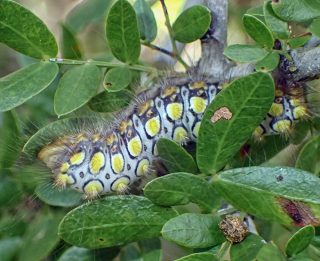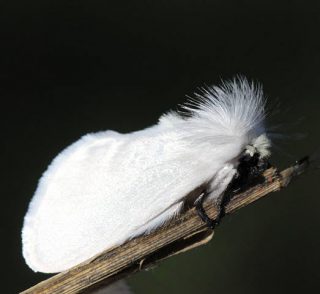
This “cat” (short for caterpillar) was one of two I saw feeding on blackbrush leaves. Notice its bright pattern of yellow polka dots. Robert Benson photo.
A “Cat” without a Name: Who You Gonna Call? (by Karen L. P. Benson)
While walking through my trails through the brush, I came across some odd caterpillars. They were very beautifully marked with bright yellow polka dots outlined in black. Each dot had a tuft of hairs sticking out of it. The caterpillars were busily eating blackbrush leaves.
I had never seen anything like these caterpillars. What kind of insect uses blackbrush as its larval food? I wondered if such spectacular caterpillars would turn into some sort of special Brush Country butterfly. It was time to get out the field guides.
Unfortunately, I have no guide for identifying caterpillars. I am not sure if one even exists. Certainly, there is no comprehensive field guide to caterpillars. Still, caterpillars turn into butterflies and moths, so I could check those books. Many of the butterfly field guides also have pictures of the adults’ larval forms. At least, they have pictures for some butterfly and moth caterpillars, although not all.
I skimmed through several references with no luck. My caterpillars were unusual. I had to call in the experts. By experts, I mean the lepidoptera websites and our local lepidoptera aficionado: Jimmy Jackson. I sent him my photos.
Between Jimmy’s expertise and the websites’ vast collection of photos, we narrowed the identification down to a moth: Norape virgo. There was no other name given except the scientific name. What? A species that has no common name?

Have you ever seen such a pretty moth? It is a member of the flannel moth family. But surely it deserves a special common name, maybe something like “Exquisite Kitten Moth”? Thomas Bentley photo.
This was hard to believe given how striking the caterpillars were. It was even more unbelievable when I saw the adult moth. It was exquisite. It was all soft, fuzzy, and snowy white. It reminded me of a pure white kitten. Surely someone would have nicknamed Norape virgo. It could be called “white moth,” or “snowy moth,” or maybe even “kitten moth.”
Norape virgo was described in 1877 by Arthur Gardiner Butler. He gave it this scientific name because it resembled other moths in the Norape genus. For its species name, he decided on “virgo” (virgin) for its pure white color. But he didn’t give it any common name, as far as I could tell.
However, as I searched the Internet for Norape virgo, I did find some common names: White Flannel Moth…well, that fits! And Yellow-spotted Caterpillar. It was almost as if they were two different creatures. N. virgo is found from south Texas and southern Arizona to Colombia. Its larvae feed on legumes. One of the most common legumes in the Brush Country is blackbrush acacia, so it was not surprising to find those caterpillars on that plant. It was a bit unusual though to find the caterpillars this far north. Norape virgo has been more or less limited to the Rio Grande Valley in Texas (or so I thought).
There were 31 observations of this species posted on iNaturalist for the past three years. Most of these were from Mexico and the Valley. However, five sightings of caterpillars and three sightings of adult moths were reported for the Coastal Bend of Texas. I wonder if the species has been extending its range northward in the past few years, a possible effect of global warming. It might be that we are just getting more observant. I know that I am becoming more observant. Perhaps you are too.
The more observers watching the natural world, the more we know about life on Earth. Records of observations made over time, can indicate changes in the complex web of species. Volunteer naturalists have been adding a lot to our picture of what is happening around the globe.
A case in point is the “insect Armageddon” that has made headlines lately. A team of volunteer insect observers in Krefeld, Germany has been trapping, identifying and counting insects for years. In 2013, they noticed that their “bug counts” were much lower than they had been a couple of decades ago. They repeated their counts for several more years. They sampled in 63 nature preserves in northern Germany. The data were astounding…and very disturbing. These volunteers documented a 75% decline in insect numbers in the past three decades. And that was in protected areas in Europe! What might be occurring in other countries and around the world?
When I see the strikingly patterned caterpillars and such a pretty moth as Norape virgo, I really hope that an insect Armageddon is not happening here.
Column by Karen L. P. Benson
